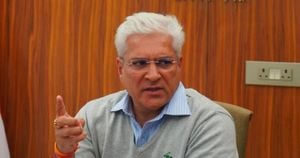Severe smog has engulfed northern India and parts of Pakistan, leading to emergency measures aimed at protecting public health as air quality plummets to hazardous levels. New Delhi, the capital of India, is experiencing unprecedented pollution, with air quality index readings surpassing 1,600, making it the most polluted city worldwide. Schools have closed, outdoor activities are restricted, and residents are being urged to stay indoors, effectively signaling what officials describe as a medical emergency.
The alarming levels of air pollution can be attributed primarily to two factors: agricultural practices and meteorological conditions. Each autumn, farmers burn stubble left over from rice harvests, releasing significant quantities of pollutants. To make matters worse, cool weather traps these pollutants within the atmosphere, resulting in thick blankets of smog. Areas such as Punjab province, which borders India, have been severely affected, with pollution levels above 1,000 reported, contributing to respiratory ailments among residents.
Delhi's Chief Minister Atishi Marlena Singh has condemned the situation, stating, "All of North India has been plunged back to the state of medical emergency due to air pollution." During recent press conferences, Singh criticized the central government's lack of action to curb stubble burning, which she claims is exacerbated by inadequate air quality regulations across neighboring states. Such comments reflect longstanding tensions between state and central governments over pollution management.
On the pollution scale, figures have been astronomically high. The World Health Organization (WHO) recommends air quality levels remain under 25 micrograms per cubic meter for safe breathing. Unfortunately, recent data indicates New Delhi's PM2.5 levels soared to 140 times this safety threshold. Such conditions lead to potential health risks, including eye and throat irritation, and can provoke serious long-term health issues, particularly for vulnerable populations such as children and the elderly.
Complaints from residents are commonplace, with many expressing deep concerns about their health and the growing inability to breathe easily. Social media platforms reveal anguished posts from Delhites grappling with everything from irritated throats to severe respiratory problems, casting light on the real human impact of this crisis. One resident recounted, "Even two air purifiers are not making the AQI breathable indoors. Children are breathing in what feels like gas chamber air." Another suggested mass protests to draw attention to the intolerable air quality, declaring, "The air we breathe is lethally toxic."
Reports have shown evidence of how bad the air quality truly is. According to the Swiss air quality monitor IQAir, readings on the Air Quality Index (AQI) spiked over the weekend, with many measuring above 484, classified as “severe plus.” Such conditions have not only compelled families to shutter windows but also lead to flight disruptions, as visibility dropped to under 100 meters throughout certain regions of the city, with landmarks like India Gate shrouded by smog.
Although Delhi's pollution has garnered significant media attention, neighboring Pakistan has faced similar challenges. The province of Punjab has been battling hazardous levels of air pollution over the past weeks, marking the area as one of the most polluted globally. The chief minister of Punjab has echoed similar sentiments, expressing the urgent need for government intervention. Measures have included restrictions on outdoor activities, the closing of schools, and advisories urging residents to exercise caution. Under these circumstances, public health facilities report increased cases of respiratory illnesses accompanied by allergies and other air quality-related ailments.
Despite persistent problems, efforts are underway to tackle the crisis. The Delhi government has activated emergency protocols which include stricter measures under the Graded Response Action Plan (GRAP). Among these measures is the banning of heavy-duty trucks, restrictions on construction activities generating additional dust, and the encouraging of remote working arrangements for employees. Schools have moved classes online to minimize exposure, with only students preparing for board examinations permitted to attend physical classes.
Experts suggest climate and weather patterns also significantly contribute to worsening conditions, emphasizing the importance of comprehensive and immediate actions. Mahesh Palawat, head of meteorology at Skymet Weather, remarked, "If people are non-smokers, at these pollution levels, they're inhaling the equivalent of 30 to 40 cigarettes per day. You can only begin to fathom the health risk involved.” He added the air quality is expected to remain very poor at least for several more days, with the need for public health officials to prepare for mounting health crises.
Long-term solutions must also be sought to address the root causes of this toxic atmosphere. Consequently, environmental activists advocate for substantial reforms concerning agricultural practices, particularly the stubble burning which has become instrumental to the problem. They argue for investments toward technology and techniques aiding farmers to manage their crop residues without resorting to burning, which could provide immediate relief to air quality concerns and positively influence public health.
The crisis has revived discussions about the role of political leadership. Critics argue both the Indian and Pakistani governments must accelerate actions toward sustainable solutions, particularly with three million people reported to die from air pollution globally each year. Experts warn without solid policies and decisive action, the legacy of air pollution will continue to affect generations to come.
While countries across the globe adapt strategies to combat air pollution, the current smog emergency reminds us of the urgent need to prioritize the well-being of citizens above political disagreements. A collective effort from both regimes will be necessary to mitigate what has become an annual struggle against air pollution, ensuring healthier futures for all impacted residents.
Delhi and Punjab’s air pollution problems embody more than just local environmental challenges; they highlight the urgent need for unified response strategies and policies which prioritize public health and address core environmental issues. With significant political will and community involvement, it is possible to combat the smog crisis and bring more breathable air back to the regions.



